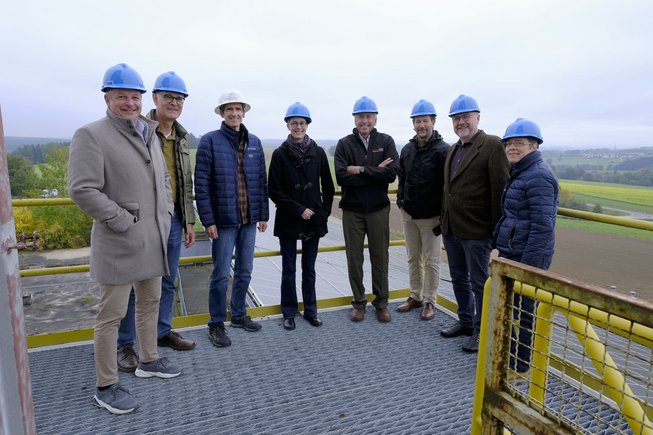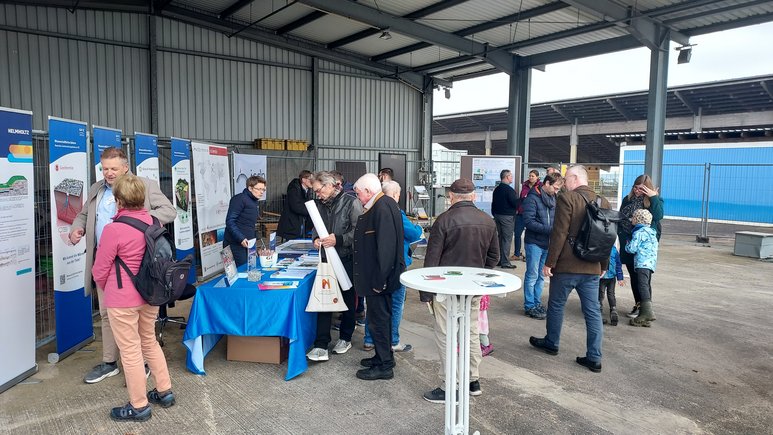30 years of KTB – An occasion to celebrate
Thirty years ago, on 12 October 1994, the deepest borehole in Germany near the Bavarian town of Windischeschenbach reached its final depth of 9101 metres below the surface – after 1468 days of drilling. It was the highlight of the Federal Republic of Germany's Continental Deep Drilling Programme (KTB). The first German large-scale geoscientific research project began in 1987 and ended in 1995 with the aim of directly exploring the Earth's continental crust with unprecedented accuracy.
One of the scientific-political consequences of the KTB programme was the founding of the German Research Centre for Geosciences (GFZ) in 1992. The KTB programme also gave rise to the International Continental Scientific Drilling Programme (ICDP), which was founded in 1996 and is based at the GFZ. Even today, the nine-kilometres-deep main borehole and the four-kilometres-deep neighbouring pilot borehole provide a unique deep laboratory that is still used by the GFZ for research purposes, for example on geothermal energy issues.
The 83 metres high drilling tower is still a monument that can be seen far into the country. The GEO Centre on the site provides information about the geosciences in an educational and meeting place.
Celebration and open day
Three anniversaries were celebrated there on Friday, 18 October: 30 years of reaching the KTB’s final depth, 20 years of the GEO Centre foundation and 20 years of the GEO-Labor school laboratory. Among the numerous guests from science, drilling, school and politics was a delegation from the GFZ led by the Scientific Director, Prof. Susanne Buiter, who gave one of the keynote speeches. She looked back on the far-reaching achievements of the unique borehole. Also present was this year's winner of the GFZ Rolf Emmermann Medal, Prof Mark Zoback from Stanford University, USA, a pioneer of scientific drilling.
Following the ceremony, more than 400 interested visitors attended the open day, where the GFZ and ICDP presented themselves alongside the GEO Centre, including the drilling rig and regional (research) facilities.
For some impressions: view the pictures in the above slider.
Research boreholes are our telescope into the Earth
Boreholes not only provide direct insights into the uppermost layers of the Earth and their properties. Without samples directly from the depths and underground measurements, central questions of geosciences cannot be solved: the origin of earthquakes and volcanic eruptions; the course of climate and environmental changes over many millennia, imprinted in rock layers that lie deep in the Earth today; the formation and extraction of georesources for a sustainable energy supply such as geothermal energy and raw materials; or the formation of continents and life.
KTB – Records and innovations
The aim of the KTB continental deep drilling programme of the Federal Republic of Germany was the direct exploration of the Earth's continental crust – its physical and chemical rock properties, temperatures and stresses – with unprecedented accuracy.
To this end, many innovative drilling and monitoring technologies, scientific methods and patents were developed and tested, which today serve as the standard for research and exploratory drilling, for example directional drilling techniques and the automation of drill rods.
A drill core was taken almost continuously from the 4-kilometres-deep pilot borehole, an important basis for the scientific investigations.
The 9-kilometres-deep main borehole is still the deepest scientifically accessible borehole and one of the deepest man-made points below the Earth's surface. It is considered to be the ultra-deep borehole with the smallest horizontal deviation in the world of less than 15 metres between the surface and a depth of 7,500 metres. This was possible thanks to a specially developed drilling process that actively counteracted the deviation.
As the depth increases, the temperature rises and the material properties of the rock drilled through change: from brittle rock, i.e. hard and crumbly, to ductile, like very viscous flowing honey. At some point, it becomes too warm to drill deeper. Temperatures of around 265 degrees Celsius prevailed at a depth of 9,101 metres.
Today, the two boreholes are filled with formation fluid and water. At the bottom of the main borehole is a broken probe, so geophysical experiments are only possible to a depth of 6.7 kilometres – still a considerable depth.
The KTB programme brought new, groundbreaking scientific findings, including
- on geophysical structures and phenomena:
seismic reflectors, electrical, magnetic and gravimetric anomalies; calibration of deep sounding methods - on the Earth's stress field and the transition from brittleness to ductility:
orientation and magnitude of mechanical stress as a function of depth; generation and triggering of earthquakes - on the thermal structure of the Earth's crust:
temperature distribution, heat flow, heat production; geothermal energy - on fluid and transport processes:
fluid sources, fluid pathways and budget; occurrence and distribution of mineral deposits - on the structure and development of the Palaeozoic crust of Central Europe:
characteristics, deformation mechanism and dynamics of a reactivated crust
Consequence of the KTB: Foundation of GFZ and ICDP
The GFZ German Research Centre for Geosciences was founded in 1992 to retain and further develop the geoscientific and technological expertise gained from such a large-scale project and to make it available to the (scientific) community. It was established in Potsdam on the Telegrafenberg, on the site of the former Central Institute for the Physics of the Earth (ZIPE) of the GDR, which was another nucleus and from which many employees and expertise were transferred.
In 1996, the International Continental Scientific Drilling Programme (ICDP) was founded with an office at the GFZ. As an international organisation, ICDP promotes and supports geosciences in the field of scientific continental drilling financially and with technical and scientific equipment and know-how. The ICDP currently has 23 member states. The steering group (‘Operational Support Group’) is located in the GFZ section 4.2 ‘Geomechanics and Scientific Drilling’.
More information on scientific drilling can be found on the GFZ focus pages and on the ICDP website.
Further information about the KTB can be found on the website of the GEO Centre (German only).
A report about the anniversary on the Bavarian local TV "Oberpfalz tv" otv.





















![[Translate to English:] [Translate to English:] Abror Gafurov von dem Schriftzug "Welcome to Azerbaijan" und den UN und COP Logos](/fileadmin/_processed_/2/5/csm_2024_11_Baku_COP29_Abror_Gafurov_1042faec82.jpeg)


![[Translate to English:] Martin Herold standing in front of the library on the Telegrafenberg](/fileadmin/_processed_/c/d/csm_Martin_Herold_d385ee4dd9.jpeg)
![[Translate to English:] Many people are listening to a presentation in the GFZ lecture hall.](/fileadmin/_processed_/c/a/csm_1_Bild1_hell_b9c0e9f5ed.jpeg)





![[Translate to English:] Both scientists sitting on stools in front of a wall of books in the Telegrafenberg library](/fileadmin/_processed_/6/6/csm_Buiter_Castell_DORA_4_e87cb1ea18.jpeg)
![[Translate to English:] Gruppenbild mit 4 Personen](/fileadmin/_processed_/8/d/csm_20241017_GFZ-Emmerman-Medal-005_web_reinhardtundsommer_21a414fa4a.jpeg)






![[Translate to English:] Ice landscape with five red tents](/fileadmin/_processed_/8/9/csm_Zeltlager_auf_dem_Eis_Urheberin_Jenine_McCutcheon_5ced2d523b.jpeg)



